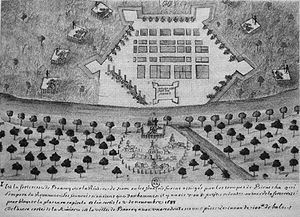| Siamese Revolution | |||||||
|---|---|---|---|---|---|---|---|
 The siege of the French fortress in Bangkok by the Siamese revolutionary forces of Phetracha in 1688. | |||||||
| |||||||
| Belligerents | |||||||
|
| |||||||
| Commanders and leaders | |||||||
|
Phetracha Luang Sorasak Krommaluang Yothathep |
Constantine Phaulkon Mr de Vertesalle | ||||||
The Siamese revolution of 1688 was a major popular uprising in the Siamese Ayutthaya Kingdom (modern Thailand) which led to the overthrow of the pro-French Siamese king Narai. Phetracha, previously one of Narai's trusted military advisors, took advantage of the elderly Narai's illness, and killed Narai's Christian heir, along with a number of missionaries and Narai's influential foreign minister, the Greek adventurer Constantine Phaulkon.[2] Phetracha then married Narai's daughter, took the throne, and pursued a policy of ousting French influence and military forces from Siam. One of the most prominent battles was 1688's Siege of Bangkok, when tens of thousands of Siamese forces spent four months besieging a French fortress within the city. As a consequence of the revolution, Siam severed significant ties with the Western world, with the exception of the Dutch East India Company, until the 19th century.
- ^ De la Touche, in Smithies 2002, pp. 66–71
- ^ Strathern, Alan, ed. (2024), "Repulsion from Siam: The Revolt of 1688", Converting Rulers: Kongo, Japan, Thailand, Hawaii and Global Patterns, 1450–1850, Cambridge University Press, pp. 217–244, doi:10.1017/9781108569729.013, ISBN 978-1-108-47716-1